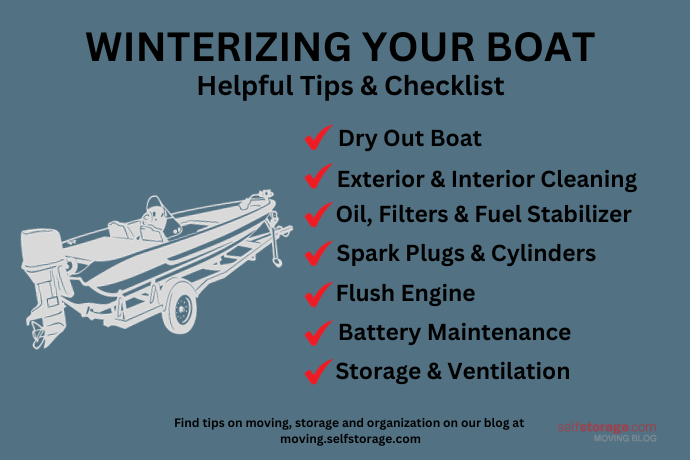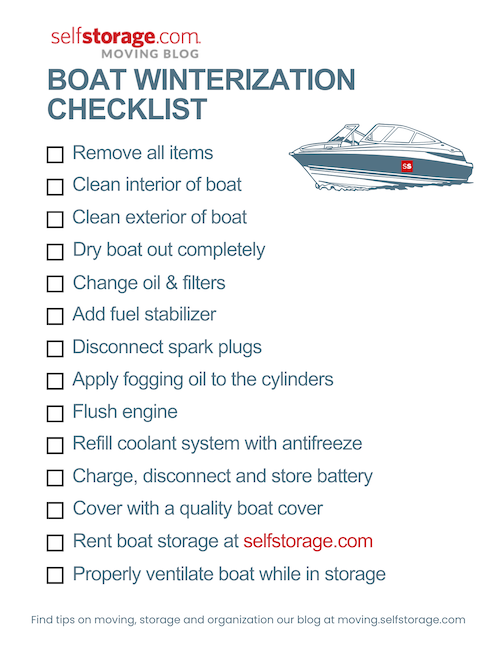What’s covered in this article – click on a link to learn more:
Whether you use it for fishing, waterskiing, transportation or simply for pleasure cruising, your boat is an investment that needs proper maintenance to ensure its performance and longevity. One of the best ways to give your vessel the TLC it deserves is to give it thorough attention during the winterization process.
Continue reading to learn about the crucial stages of winterizing your boat. From meticulous cleaning and thorough water drainage to safeguarding your engine and battery, we will also delve into the importance of securely covering and properly storing your vessel, ensuring a seamless return to the waters in the upcoming boating season.
Cleaning the Boat For Winter
At the end of boating season, it’s essential to give your boat a thorough cleaning before tucking it away for the winter months. Removing all the built-up grime and dirt will be much easier now than in the spring after all the grunge sits and solidifies over winter. A solid cleaning will also reveal any issues that may need urgent attention and provide a clean slate for the next boating season.
Here are some tips for effective cleaning:
- Remove all belongings from the craft.
- If you’ve got a larger vessel, use the “Inside-Out” approach. Start with the cabin, saloon, etc. and work your way to the outer deck and hull.
- Power wash your hull. This will remove all grime, marine life and older wax. It’s a good idea to apply a fresh coat of wax at this point for an extra layer of protection.
- Clean off the propeller.
- Wipe down seats, trim and flooring, and vacuum all carpets and upholstery.
- Inspect and clean the bilges.
Removing Water from the Boat
It seems ironic that water can damage a boat, but it can. Any water left on your vessel can freeze during the winter months and cause extensive damage, especially to the motor. To avoid this potentially costly mistake, be sure to do the following:
- Inspect the bilge for standing water and remove it using a bilge pump, then dry the area thoroughly. This will prevent mold growth and structural damage.
- Once the bilge is dried, you should spray it with a moisture-displacing lubricant.
- Drain the plumbing system if applicable. This includes sinks, toilets, pipes, heads, seacocks and water tanks.
- When all water is effectively removed from your boat, ensure that it is properly ventilated during storage to prevent moisture buildup.
Winterizing the Boat’s Engine
When the cold weather sets in, the well-being of your boat’s engine should be your number one priority. Here are the steps to safeguard it from the harsh effects of winter:
- Swap out used oil and filters for fresh ones to prevent corrosion.
- Disconnect spark plugs and apply fogging oil to the cylinders to prevent rust from forming.
- Use fresh water to flush the engine, eliminating salt and dirt. Refill the coolant system with antifreeze.
- Drain the cooling system and refill it with marine engine antifreeze to avoid damage caused by freezing.
- Change the fuel filter and top off your engine’s gas tank with a mixture of fuel and stabilizer. This preserves fuel quality and prevents engine issues.
- Shield the engine with a waterproof tarp or canvas to prevent exposure to the elements.
By completing these steps, you’ll ensure that your boat’s engine remains in optimal condition throughout the winter. You’ll also enjoy a seamless transition into the next boating season.
Protecting the Boat’s Battery Over Winter
Your boat’s battery needs proper pre-winter care to keep functioning at high capacity. Cold weather can damage your battery leading to costly repairs or replacement come spring. To avoid these problems, do the following:
- If you’re not storing your boat in a heated indoor facility, disconnect your battery and give it a thorough cleaning.
- Make sure your battery is fully charged before storing it for the winter.
- Store your battery in a cool, dry space. Do not keep it on a concrete floor as this will drain the battery.
- Check on your battery every few months and recharge it as needed.
- Consider using a trickle charge boat battery while the boat is in storage.
Protecting Your Boat with a Cover
Finding a quality boat cover for your vessel is essential for the harsh winter months. Covers are the primary defense against the cold elements, animals, mildew and debris. To maintain your boat’s cleanliness and structural integrity, you’ll need to buy a suitable and sturdy cover.
Be sure to choose a cover that protects your boat from damaging UV rays, corrosive saltwater (if applicable), moisture and high winds. Here are the three basic types of covers to choose from:
Plastic Boat Covers: These are typically affordable and easy to find. Just make sure it’s marine-grade with UV protection.
Canvas Custom Boat Covers: These are more expensive than plastic covers but they’re tougher and will snugly fit your boat’s design, making it a better choice when it comes to closing gaps. It’s a good idea to apply waterproof sealant to your canvas cover every few seasons.
Shrink Wrap Boat Covers: These covers are made to fit your boat like a glove and are considered the top line of defense. They’re designed to keep animals out, shed water and even large amounts of snow. Because they are so snug, it’s best to install them with vents to prevent mold growth.
Winter Boat Storage
While the idea of keeping your boat in the water during winter might be appealing, particularly if your region doesn’t face freezing temperatures, taking your boat out of the water is the best choice to protect it from the elements. And keeping it at the marina can be convenient, but is usually much more expensive.
Essentially, you have two options when it comes to storing your boat: indoor or outdoor storage. A convenient option would be to store it in your own garage, boathouse or shed. If that is not an option for you or you don’t have the space to accommodate a large vessel, secure boat storage may be your best bet.
Outdoor boat storage typically consists of large uncovered parking spaces where you can keep your boat on a trailer, which means it doesn’t fully protect it from harsh weather, dust or dirt.
Another option that keeps your watercraft protected from the elements year-round is with stack or dry stack storage. This type of boat storage uses multi-level racks to securely hold vessels of all shapes and sizes. The downside of stack storage is that it’s more time consuming to access your boat because it’s stacked on a large rack with other boats or may be inside a large warehouse (dry stack storage).
The last, and most expensive, option is indoor boat storage. The upside to spending more on indoor boat storage is that it protects your boat from long-term damage. Your boat is typically housed in a large warehouse building where multiple watercrafts are stored in a single, expansive room.
What should you consider before making a final decision?
- How much access you’ll need to your boat in the off-season.
- The winter climate in your area.
- The distance between the storage area and the boat’s launch site.
- The level of security you’re comfortable with.
- Which storage option best suits your budget.
- The reputation of the facility.
Additionally, make sure you’re comfortable with the storage facility’s policies and contract terms. You should also check to see if your boat insurance covers storage.
Boat Winterization Checklist
This comprehensive checklist will help ensure your boat’s protection and keep it in water-worthy shape.
- Remove all items from the boat and give it a thorough cleaning, inside and out.
- Get rid of all standing water and make sure the boat is bone dry before storing it.
- Change out the oil and filters, then add a fuel stabilizer.
- Disconnect the spark plugs and apply fogging oil to the cylinders.
- Flush the engine and refill the coolant system with antifreeze.
- Charge, disconnect and store your battery in a cool, dry space. Recharge as necessary.
- Purchase a quality boat cover.
- Do your homework and store your boat somewhere you know it will be safe and protected from the elements.
- Make sure the boat is properly ventilated while in storage.
When it comes to a significant investment like a boat, taking the proper winterization steps is essential to ensuring its longevity and maintaining its value. By taking these measurements seriously, you’re more likely to enjoy smooth sailing once the warmer days return.
Here’s a helpful video if you prefer your boat tips in a visual format.





